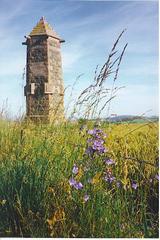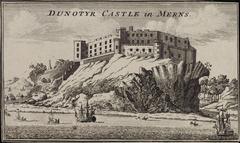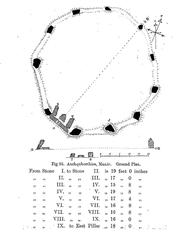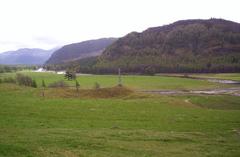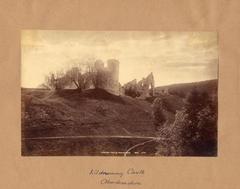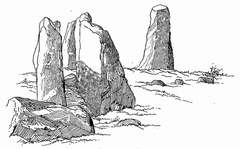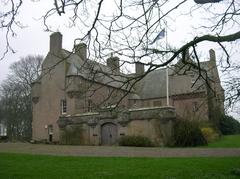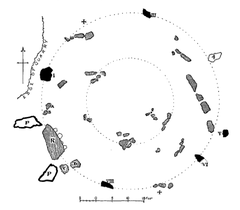Christchurch, Stone Circle And Standing Stone, Midmar
Christchurch Stone Circle and Standing Stone, Midmar, Ballater, United Kingdom
Visiting Hours, Tickets, and Historical Sites Guide
Date: 14/06/2025
Introduction
The Midmar Stone Circle—also known as the Christchurch Stone Circle or Midmar Kirk Stone Circle—is a remarkable prehistoric monument nestled in the kirkyard of Midmar Parish Church, near Ballater in Aberdeenshire, Scotland. Dating from approximately 2500–1500 BCE, this recumbent stone circle is a well-preserved example of the megalithic monuments unique to northeast Scotland. Its striking ring of granite stones, carefully aligned for astronomical events, offers visitors a direct link to the spiritual and ritual practices of Scotland’s Neolithic and Bronze Age communities. Integrated into a Christian sacred landscape, the site reflects a fascinating continuity of spiritual significance from ancient times to the present.
This comprehensive guide provides in-depth information about the historical, cultural, and archaeological significance of the Midmar Stone Circle, as well as practical details for visiting. Whether you are a student of history, a heritage enthusiast, or a curious traveler, this article will help you make the most of your visit to one of Aberdeenshire’s most captivating ancient sites.
Table of Contents
- Origins and Construction
- Archaeological Investigations and Modifications
- Cultural and Ritual Significance
- Visiting Information: Hours, Tickets, and Accessibility
- Nearby Attractions and Events
- Visuals and Media
- Comparative Context: Recumbent Stone Circles of Aberdeenshire
- Folklore and Local Traditions
- Conservation and Heritage Management
- Visitor Guidelines and Responsible Tourism
- FAQ
- Conclusion and Call to Action
- References
Origins and Construction
The Midmar Stone Circle is a classic example of the recumbent stone circles found predominantly in Aberdeenshire. These circles were constructed between 2500 BCE and 1500 BCE, during the transition from the Neolithic to the Bronze Age (Visit Aberdeenshire). The circle measures approximately 17–17.3 meters in diameter and originally consisted of a massive recumbent granite stone, flanked by two imposing upright stones—known as flankers—along with a ring of six to ten smaller upright stones.
The recumbent stone, estimated to weigh around 20 tons, lies horizontally in the southwest arc of the circle, a feature unique to this monument type. The two flankers reach up to 2.5 meters in height and frame the recumbent stone with an impressive, fang-like appearance. The arrangement reflects both ritual intent and a sophisticated understanding of astronomy, as the alignment may correspond to significant lunar or solar events.
Archaeological Investigations and Modifications
The site has undergone several phases of alteration and investigation. In 1914, the churchyard was expanded around the stone circle, and an internal ring cairn—often associated with burials—was removed (Stones of Wonder). While this improved the visibility of the circle, it also altered the original archaeological context. Nevertheless, the principal features remain intact and the circle is considered a well-preserved example of its type.
Archaeological studies of recumbent stone circles across Aberdeenshire have revealed that these monuments were constructed with careful attention to the landscape and celestial cycles. Though specific excavation data for Midmar is limited, the broader typology supports interpretations of ritual, ceremonial, and astronomical use (Visit Aberdeenshire).
Cultural and Ritual Significance
The exact function of recumbent stone circles remains debated among scholars. Leading theories propose that these monuments served as ceremonial gathering places, sites for funerary rites, or observatories for tracking lunar and solar cycles. The southwest orientation of the recumbent stone at Midmar suggests potential alignments with midsummer sunsets or major lunar events (Historic Environment Scotland).
The enduring presence of the circle within a Christian churchyard is a testament to the site’s long-standing spiritual importance. It symbolizes the layering of sacred traditions, with ancient megalithic rituals giving way to Christian worship yet remaining physically and symbolically present in the landscape.
Visiting Information: Hours, Tickets, and Accessibility
- Opening Hours: The site is open year-round during daylight hours.
- Tickets: Free entry; no tickets are required.
- Location: Midmar Parish Church, Aberdeenshire (AB51 7NA), approximately 12 miles west of Aberdeen.
- Parking: Limited parking available adjacent to the church; not suitable for large buses.
- Accessibility: Terrain is flat but unpaved; visitors with mobility concerns should plan accordingly.
- Facilities: No public restrooms; nearest facilities in local villages.
Visitors are respectfully reminded that the circle is situated within an active graveyard. Please maintain quiet, avoid climbing on the stones, and keep dogs on leads.
Nearby Attractions and Events
Aberdeenshire boasts a wealth of prehistoric and historic sites. Consider visiting other notable circles such as Easter Aquhorthies and Loanhead of Daviot, or castles like Crathes and Balmoral. Occasional guided tours and solstice events are organized by local heritage groups. Check parish and tourism websites for schedules (Visit Aberdeenshire).
Visuals and Media
High-quality images of the Midmar Stone Circle can be found on regional heritage websites. These resources offer panoramic views, detailed photographs of the recumbent and flanking stones, interactive maps, and occasionally virtual tours. For accessibility and SEO, images should use alt text such as “Midmar Stone Circle Aberdeenshire” or “recumbent stone circle Scotland.”
Comparative Context: Recumbent Stone Circles of Aberdeenshire
Midmar is one of more than seventy recumbent stone circles in Aberdeenshire. These circles are characterized by a massive recumbent stone, two tall flankers, and a ring of smaller uprights. Their construction required significant communal effort and reflects the importance of ritual practice and astronomical observation in prehistoric society. The concentration of these circles in northeast Scotland makes the region a focal point for megalithic studies (Visit Aberdeenshire).
Folklore and Local Traditions
Like many ancient sites, the Midmar Stone Circle has inspired local legends, though specific folklore is less documented than at other circles. Recumbent stone circles are often associated with tales of giants, druids, or supernatural events. The siting of the monument within a churchyard may reflect a deliberate Christian appropriation of earlier sacred spaces, a practice seen elsewhere in Scotland (Visit Aberdeenshire).
Conservation and Heritage Management
The Midmar Stone Circle is a Scheduled Monument under the Ancient Monuments and Archaeological Areas Act 1979. This legal status prohibits unauthorized alterations and ensures the site’s archaeological integrity (Historic Environment Scotland). Local stewardship is provided by Midmar Kirk parish, supported by regular monitoring from heritage authorities.
The graveyard context provides both protection and challenges. While regular maintenance deters vandalism and overgrowth, grave digging and landscaping can disturb subsurface deposits. The circle is stable as of June 2025, with ongoing passive conservation.
Visitor Guidelines and Responsible Tourism
- Stay on established paths; do not climb or sit on the stones.
- Respect churchyard activities and ceremonies.
- Take litter with you; do not disturb graves or archaeological features.
- Dogs must be kept on leads.
- Photography is permitted; drone use requires permission.
FAQ
Q: Are tickets required to visit the Midmar Stone Circle?
A: No, the site is free to visit year-round.
Q: What are the best times to visit?
A: Early morning and late afternoon offer the best light for photography and a peaceful atmosphere.
Q: Is the site wheelchair accessible?
A: The ground is mostly level but may be uneven; accessibility may be limited in wet weather.
Q: Are guided tours available?
A: Local heritage groups occasionally organize guided walks, especially at solstice times.
Q: Where can I find facilities?
A: There are no restrooms on site; nearby villages such as Echt and Banchory have public facilities.
Conclusion and Call to Action
Midmar Stone Circle is a compelling testament to Scotland’s prehistoric landscape, blending ancient ritual, astronomical sophistication, and enduring spiritual significance. Its accessible setting, free entry, and tranquil atmosphere make it an essential stop for anyone interested in Scottish history and heritage. By observing responsible tourism practices and respecting both the ancient stones and the modern churchyard, visitors help ensure the site’s preservation for generations to come.
To enrich your visit, download the Audiala app for interactive guides and audio tours, and consult official resources for up-to-date information. Share your experience using #MidmarKirkStoneCircle and join the community dedicated to safeguarding Scotland’s ancient monuments.
References
- Visit Aberdeenshire: Midmar Stone Circle
- Historic Environment Scotland: Midmar Kirk Stone Circle
- Stones of Wonder: Midmar
- Canmore Database: Midmar Kirk Stone Circle
- Aberdeenshire Council Archaeology Service
For further details, conservation updates, and additional visitor information, consult the linked official resources above.
